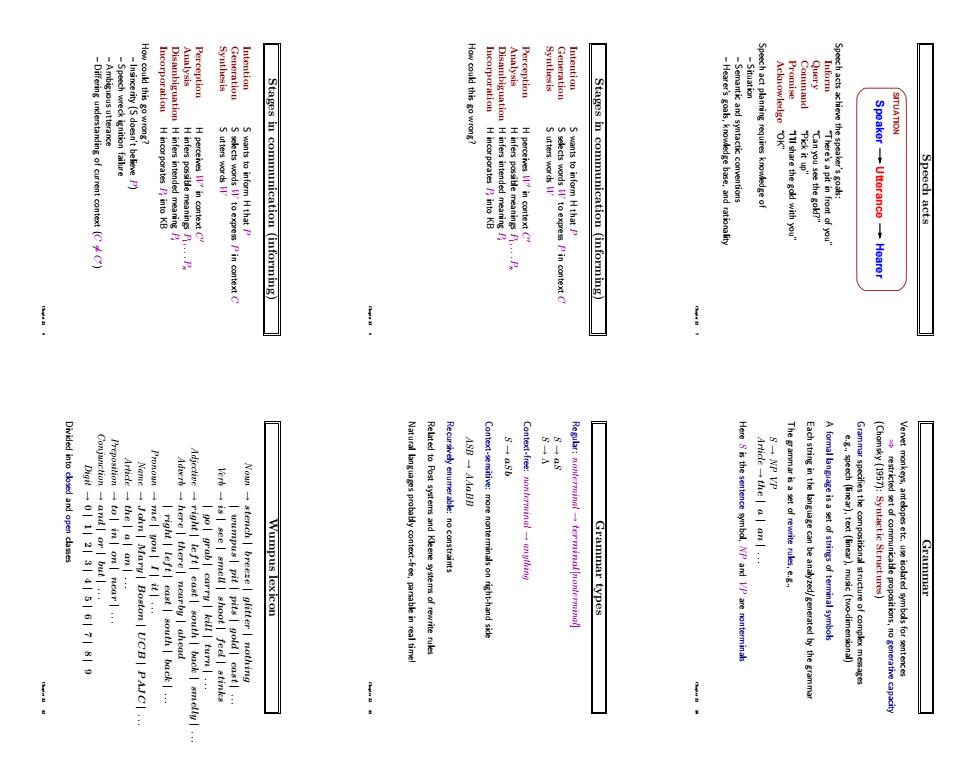正在加载图片...

How coul this go wrong? 1 SITUATION H incorporates P into KB Stages in communication (informing) Stages in communication (informing) Speech acts ↓ Hear : Context-i Contet-oe pus pit stench breese Wumpus lexicon Grammar types The gammar isa set of rewrite rules,e. A formal language is aset of strings of terminal symbols nicable prop Grammar Boston UCB|PAJCI east south back . nearby ahe left east south|back|smelly , el shoot feel ati pits gold east glitter nothing nalson right-hand sid Here S is the sentence symbol,NP and VP are nonterminal Each string in the language can be/generated by the gramm Speech acts SITUATION Speaker Utterance Hearer Speech acts achieve the speaker’s goals: Inform “There’s a pit in front of you” Query “Can you see the gold?” Command “Pick it up” Promise “I’ll share the gold with you” Acknowledge “OK” Speech act planning requires knowledge of – Situation – Semantic and syntactic conventions – Hearer’s goals, knowledge base, and rationality Chapter 22 7 Stages in communication (informing) Intention S wants to inform H that P Generation S selects words W to express P in context C Synthesis S utters words W Perception H perceives W0 in context C 0 Analysis H infers possible meanings P1, . . . Pn Disambiguation H infers intended meaning Pi Incorporation H incorporates Pi into KB How could this go wrong? Chapter 22 8 Stages in communication (informing) Intention S wants to inform H that P Generation S selects words W to express P in context C Synthesis S utters words W Perception H perceives W0 in context C 0 Analysis H infers possible meanings P1, . . . Pn Disambiguation H infers intended meaning Pi Incorporation H incorporates Pi into KB How could this go wrong? – Insincerity (S doesn’t believe P) – Speech wreck ignition failure – Ambiguous utterance – Differing understanding of current context (C 6= C 0 ) Chapter 22 9 Grammar Vervet monkeys, antelopes etc. use isolated symbols for sentences ⇒ restricted set of communicable propositions, no generative capacity (Chomsky (1957): Syntactic Structures) Grammar specifies the compositional structure of complex messages e.g., speech (linear), text (linear), music (two-dimensional) A formal language is a set of strings of terminal symbols Each string in the language can be analyzed/generated by the grammar The grammar is a set of rewrite rules, e.g., S → NP VP Article → the | a | an | . . . Here S is the sentence symbol, NP and VP are nonterminals Chapter 22 10 Grammar types Regular: nonterminal → terminal[nonterminal] S → aS S → Λ Context-free: nonterminal → anything S → aSb Context-sensitive: more nonterminals on right-hand side ASB → AAaBB Recursively enumerable: no constraints Related to Post systems and Kleene systems of rewrite rules Natural languages probably context-free, parsable in real time! Chapter 22 11 Wumpus lexicon Noun → stench | breeze | glitter | nothing | wumpus | pit | pits | gold | east | . . . Verb → is | see | smell | shoot | feel | stinks | go | grab | carry | kill | turn | . . . Adjective → right | left | east | south | back | smelly | . . . Adverb → here | there | nearby | ahead | right | left | east | south | back | . . . Pronoun → me | you | I | it | . . . Name → John | Mary | Boston | UCB | P AJC | . . . Article → the | a | an | . . . Preposition → to | in | on | near | . . . Conjunction → and | or | but | . . . Digit → 0 | 1 | 2 | 3 | 4 | 5 | 6 | 7 | 8 | 9 Divided into closed and open classes Chapter 22 12